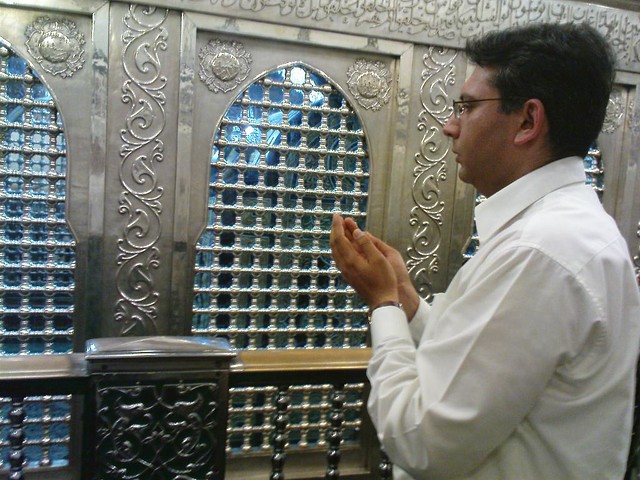
A Devotee Praying before 'Zareeh' In Cairo where Holy Head of Imam Hussain is Believed to be Buried by a section of Imamis.
Dr.Mazhar
Naqvi
The
history of Imam Hussain mosque in Cairo is somewhat similar to his father Hazrat
Ali’s shrine popular as Mazar-e-Sharif in Afghanistan. While Najaf is
considered to be the last resting place of Imam Ali, a large section of Afghani
Imamis believe that he lies buries in Mazar-E-Sharif. Likewise, Karbala is
considered as burial place of Imam Hussain but some of his admirers have believed
for centuries that his head was buried in Cairo Mosque. It implies that only body
of Imam Hussain was buried at Karbala after his martyrdom but his severed head reached
Cairo mosque around 1154 AD.
There
is no doubt that severed head of Imam Hussain was taken to Damascus and
presented in the court of Yazid(L.A.)Later on, several accounts surfaced about
the blessed head of holy Imam. While majority believe Imam Zain-ul-Abdeen
carried the blessed head through divine power to Karbala and joined it with the
body of his father. There are some people who floated the story that the head
was buried initially in Damascus.Then, it was shifted to Asqalan
in Palestine.Then,it reached Cairo on Sunday ,August
31, 1153 AD and remained buried for a year in the Fatimid palace in Khan
Al Khalili area of Cairo. Then, it was placed in a silver coffin and the
present mosque in Egyptian Capital, between Khan Al Khalili and Al Azhar became
its permanent abode. Soon a beautiful mausoleum was also erected around the
shrine. The rulers also developed it on different occasions.

Outer View of Imam Hussain Mosque in Cairo(Egypt)
Abu El Kassem Yahia built a minaret on the door of the mausoleum in
1235.It was richly decorated with beautiful arabesque on gypsum, but only the
square base with two foundation plates remained. During the reign of King Al Naser Mohamed the mosque was widened, with the construction
of an esplanade and rooms for the Alawuite jurists added in 684 H.A. In the Othman era, Sultan Salim -1st extended the
mosque to accommodate the increasing numbers of worshippers and visitors. From
1004 to 1006 H, the Othman Wali Mohamed Pasha undertook the restoration of the
mosque and its decorations. Emir Hassan Katekhda improved greatly. He also
built a wooden tomb decorated with shell and ivory with multicolor silk curtains.
Emir Abdul Rahman Katekhda and added a basin, a fountain and two halls.
There is a splendid wooden mimbar in the mosque gilded with gold. The esplanade comprises 44 columns carrying a wooden ceiling covered with very fine, multicolored plant paintings and gilded geometrical shapes. There are about thirty big bronze windows covered with gold, with small windows at the top, surrounded by marble circles. The mosque has two minarets. One was built by Abou Al Kassem in 1236. The second 17.5m minaret, located at the back, is characterized by Othman architecture and carries two plates- one with 90 verses of Sura Al Ana’am and the second a hadith of the Prophet: saying "Al Hassan and Al Hussein are the dearest members of my family to me".
The grounds of the esplanade of the green door are covered with Turkish carpets. In the mosque, one finds a door leading to the room of the relics of the Prophet, founded by Abbas Hilmi II Illuminated by lamps and crystal chandeliers. The relics of the Prophet and his companions include a piece of his shirt, the container of kohl, "marwad" (eyeliner pencil), part of his stick, two hairs from his beard and two Korans written in ‘Kufic’ style, one by Imam Ali and the other by Othman Ben Affan.
These relics were in Saudi Arabia and were bought to Egypt by an Egyptian Minister, Taj Uddin in 17th century. Despite existence of several legends about the blessed head’s burial place, Imam Hussain Mosque is held in high esteem and remains a must on the list of people visiting Cairo. A large number of them not only visit the mosque to worship but also to have a glimpse of the holy relics and its status as the burial place of Imam’s holy head among a section of people. (References available on request. Photo Courtesy Google Images)
No comments:
Post a Comment